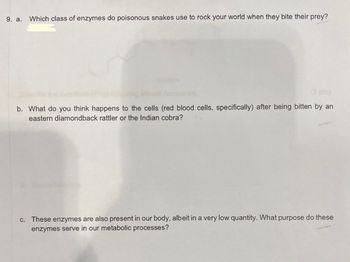
Essentials of Pharmacology for Health Professions
7th Edition
ISBN: 9781305441620
Author: WOODROW
Publisher: Cengage
expand_more
expand_more
format_list_bulleted
Question

Transcribed Image Text:9. a. Which class of enzymes do poisonous snakes use to rock your world when they bite their prey?
(3 pts)
b. What do you think happens to the cells (red blood cells, specifically) after being bitten by an
eastern diamondback rattler or the Indian cobra?
c. These enzymes are also present in our body, albeit in a very low quantity. What purpose do these
enzymes serve in our metabolic processes?
SAVE
AI-Generated Solution
info
AI-generated content may present inaccurate or offensive content that does not represent bartleby’s views.
Unlock instant AI solutions
Tap the button
to generate a solution
to generate a solution
Click the button to generate
a solution
a solution
Knowledge Booster
Similar questions
- Release of trypsin and chymotrypsin in their active form can result in the digestion of the pancreas or small intestine itself. What mechanism does the body employ to prevent its self-destruction?arrow_forwardAdenosine triphosphate (ATP) is an important molecule because it ________. is the result of catabolism release energy in uncontrolled bursts stores energy for use by body cells All of the abovearrow_forwardInsulin is released when food is ingested and stimulates the uptake of glucose into the cell. Discuss tine mechanism cells employ to create a concentration gradient to ensure continual uptake of glucose from the bloodstream.arrow_forward
- Chewing a bite of bread mixes it with saliva and facilitates its chemical breakdown. This is most likely due to the fact that ________. the inside of the mouth maintains a very high temperature chewing stores potential energy chewing facilitates synthesis reactions saliva contains enzymesarrow_forwardA scientist is studying a model that has a mutation in the receptor for somatostatin that prevents hormone binding. How would this mutation affect the structure and function of the digestive system?arrow_forwardWhich of the following is stored in the body? thiamine phosphorous folic acid vitamin Carrow_forward
- Identify the four components of a negative feedback loop and explain what would happen if secretion of a body chemical controlled by a negative feedback system became too great.arrow_forwardDoes physical exercise to increase muscle mass involve anabolic and/or catabolic processes? Give evidence for your answer.arrow_forwardIf a diabetics breath smeLls like alcohol, what could this mean?arrow_forward
- The role of the liver in digestion is to: a. synthesize aminopeptidase and dipeptidase to digestpolypeptides. b. synthesize lipase to form free fatty acids. c. secrete trypsin to break the bonds in polypeptides. d. secrete bicarbonate ions and bile salts to help emulsify fats. e. store bile between meals.arrow_forwardThe hormone insulin enhances the transport of glucose (sugar) from the blood into most body cells. Its secretion is controlled by a negative-feedback system between the concentration of glucose in the blood and the insulin-secreting cells. Therefore, which of the following statements is correct? A decrease in blood glucose concentration stimulates insulin secretion, which in turn further towers blood glucose concentration. An increase in blood glucose concentration stimulates insulin secretion, which in turn lowers blood glucose concentration. A decrease in blood glucose concentration stimulates insulin secretion, which in turn increases blood glucose concentration. An increase in blood glucose concentration stimulates insulin secretion, which in turn further increases blood glucose concentration. None of the preceding is correct.arrow_forwardWhich of these is involved in the chemical digestion of protein? pancreatic amylase trypsin sucrase pancreatic nucleasearrow_forward
arrow_back_ios
SEE MORE QUESTIONS
arrow_forward_ios
Recommended textbooks for you
- Essentials of Pharmacology for Health ProfessionsNursingISBN:9781305441620Author:WOODROWPublisher:Cengage
 Anatomy & PhysiologyBiologyISBN:9781938168130Author:Kelly A. Young, James A. Wise, Peter DeSaix, Dean H. Kruse, Brandon Poe, Eddie Johnson, Jody E. Johnson, Oksana Korol, J. Gordon Betts, Mark WomblePublisher:OpenStax College
Anatomy & PhysiologyBiologyISBN:9781938168130Author:Kelly A. Young, James A. Wise, Peter DeSaix, Dean H. Kruse, Brandon Poe, Eddie Johnson, Jody E. Johnson, Oksana Korol, J. Gordon Betts, Mark WomblePublisher:OpenStax College Biology: The Dynamic Science (MindTap Course List)BiologyISBN:9781305389892Author:Peter J. Russell, Paul E. Hertz, Beverly McMillanPublisher:Cengage Learning
Biology: The Dynamic Science (MindTap Course List)BiologyISBN:9781305389892Author:Peter J. Russell, Paul E. Hertz, Beverly McMillanPublisher:Cengage Learning Biology 2eBiologyISBN:9781947172517Author:Matthew Douglas, Jung Choi, Mary Ann ClarkPublisher:OpenStax
Biology 2eBiologyISBN:9781947172517Author:Matthew Douglas, Jung Choi, Mary Ann ClarkPublisher:OpenStax

Essentials of Pharmacology for Health Professions
Nursing
ISBN:9781305441620
Author:WOODROW
Publisher:Cengage



Anatomy & Physiology
Biology
ISBN:9781938168130
Author:Kelly A. Young, James A. Wise, Peter DeSaix, Dean H. Kruse, Brandon Poe, Eddie Johnson, Jody E. Johnson, Oksana Korol, J. Gordon Betts, Mark Womble
Publisher:OpenStax College

Biology: The Dynamic Science (MindTap Course List)
Biology
ISBN:9781305389892
Author:Peter J. Russell, Paul E. Hertz, Beverly McMillan
Publisher:Cengage Learning

Biology 2e
Biology
ISBN:9781947172517
Author:Matthew Douglas, Jung Choi, Mary Ann Clark
Publisher:OpenStax